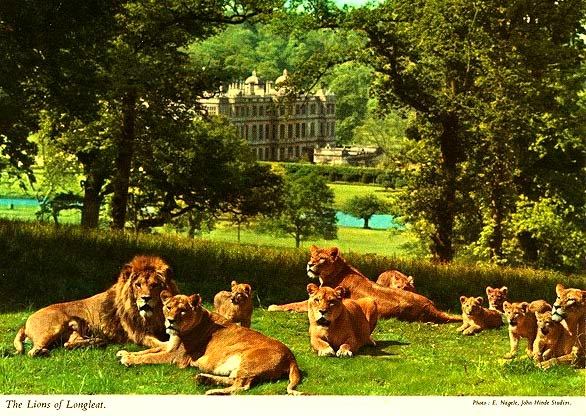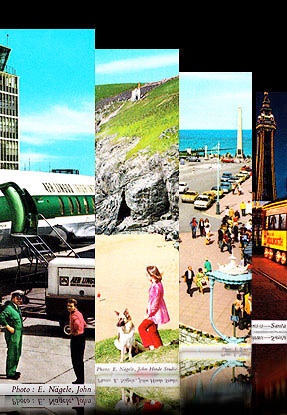Wish you were here
the early days of my photography by Edmund Nägele F.R.P.S.
Take a couple of fluffy clouds, a bunch of chrysanthemums plus a pretty freckle-faced redhead and voilà, you’ve got yourself an original John Hinde viewcard. Indeed, the finest in the world, as was proclaimed on the rotating wooden display stands and the yellow boxes in which holiday dreams were supplied to the seaside. The pretentious words on the wooden display stands and the yellow boxes were probably meant to aspire the employed photographers, rather than to dazzle the shopkeepers and the buying public. Creative Bulling one might call it today.
In these early days of 1968, the John Hinde team, all two of us, Elmar Ludwig and myself, were presented with a list of no more than 80 subjects to photograph during the yearly season of 5 months. It seemed an easy goal. We were given instructions to get the best shot possible, no matter how long it might take. And take, it did…. often several weeks to capture a single postcard snap. We shot on average only one or two sheets of 5x4 Ektachrome transparency film per subject, certainly a lot different than today’s approach of running off 160 frames on the digital flashcard. In retrospect, it saved hours of faffing around finding the best scene amongst all the thumbnails, RAW's, PSD's, ESP's, NEF's, JPEG’s and TIFF’s - if indeed, there can be a "best scene", with such a happy-go-lucky trial and error approach. The exposed sheets of film were carefully kept in a yellow Kodak film-box until our return to Ireland many months later. Here we processed the material ourselves at the little "Studio" at Bulloch Harbour. Rotten floorboards, live wires connected to the ESB (Electricity Supply Board) and fishing around for the lost sheet of film in processing chemicals might freak out today’s Health & Safety gnomes. But that sheet of film with its developing fluffy clouds was invaluable as far as I was concerned. The description "Studio" was a bit ambitious: the little old brick hut was Mr Hinde Senior’s original home but the location was simply magical, yet extremely damp on days the Irish merely called "soft". At lunchtime one could pop out to buy a packet of crisps or just a single Woodbine cigarette at the small store at the harbour quay. I gave up the habit a long time ago, but still remember those little treats with some affection.
Take the featured photograph of Longleat House with the Lions posing so prominently in the foreground. John Hinde Ltd. got the contract to produce a series of postcards for the park and house and I duly arrived with Landrover & caravan which I parked in a field full of mucky-bottomed sheep well out of lions reach, yet still within sight of the magnificent house. In the late afternoon and evenings I would undertake the interior shots whilst during the day I showed respect for giraffes, got nibbled by some little chimps and tried to get on a good footing with the main attraction: The Lions. The above mentioned shot was long in the planning and the Longleat safari Landrover was laden with fresh meat from the butcher. Off we went, throwing large lumps of prime filet steak around the scenery and eventually coaxed the big cats into a position where the house could be seen in the background. Lions are a lot worse than today’s hyperactive kids and are born with an inherent illusion of sitting on an anthill. Finally, they did settle in a group. I used a Bronica for the shoot and the first wallop of the mirror and the clattering shutter sent them bounding off in various directions without giving me so much as another look. Damn ants! One shot and 11 empty frames on the roll of film. Not a reassuring feeling, but there it is, printed in glorious four colours and on glossy paper.
John Hinde was not a man of many words though he had a good and precise idea of what his finished postcards should look like. He would sit at the light-table, looking at and scrutinising our work in silence, umming and arring though, I soon realised, this umming and arring was equivalent to the purring of a happy cat. If the purring stopped, you started to worry. Why, he might ask, didn’t or did you do this or that… Quick plausibility developed into a form of art I never thought I possessed! About 10 minutes to look and mask-up each and every single transparency meant that there was a fair amount of umming and arring to be endured in the process.
After John had masked the transparencies, black and white negatives and the prints for the colour-notes would be made. More umming and arring behind closed doors: John himself would prepare these instructions for the colour separations, which were produced in Milan (Italy). No PhotoShop in those days, only skilled Milanese Signores who would change colours, follow the scribble "make new sky" to the letter and insert the perfect holiday wish. They would eagerly remove objects of lesser desire; telephone posts and TV-aerials scored especially high. More desirable items included people and cars, thus the scribbles became frantic: "make jumper red" and "change colour of car to yellow". Why red or yellow? Simple, it made the finished cards stand out on the rotating wooden display stands and make our competitors tear out their hair. It would take some 6 months before the printed colour proofs were transferred from one republic to the other. It was a very slow and expensive process, but also exciting to see ones work in its first form of print.
People always played an important part in JH postcards; they gave the picture life, a point of interest and more importantly, a blob of colour. People were happy to while away their time posing for some crazy guy with a foreign accent and gladly pointed towards a far distance of nothing. Money was just a five-letter word, though we sometimes offered it in exchange for flowers from a cottage garden. Not to charm some pretty Irish maidens, but for foreground props! Never once was cash accepted. Quite the contrary, kind people would offer tea and chocolate biscuits plus the time to chat with you. I remember one occasion when I was perched on the roof of my Landrover taking a shot of Portrush along the glorious Antrim Coast of Northern Ireland. There was a Sunday lunchtime program on the BBC which I enjoyed so many years ago, something to do with Black & White Minstrels singing "Maaaa, He's Making Eyes at Me". And believe me, I wasn't the only one enjoying the midday mocking of Political Correctness – PC and New Labour wasn’t part of the English vocabulary yet. Happy days indeed! Anyway, there I was on top of a green lump of tin, when two old ladies enquired, what might I be doing with that strange contraption and the piece of cloth under which I disappeared from time to time. I explained; well, I tried to explain. And as on so many occasions in Ireland, things dragged on and off the subject thus pretty soon the obligatory tea and chocolate biscuits followed in the surroundings of one of the most beautiful private country houses I have ever visited – sort of Agatha Christy stuff and totally over the top for anybody of a slight socialist incline. On parting, the lovely ladies handed me a little red book of Irish poetry which I still treasure to this day. Whatever has happened in these past 56 years, that has taken away this kindness and concern for others that the British people displayed in such a plentiful and natural way?
Wish you were there? Bet you do!
Buy the book of postcards NOTHING TO WRITE HOME ABOUT by Michelle Abadie & Susan Beale or view a fascinating collection of cards at the John Hinde Collection





